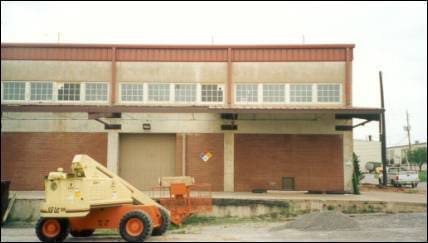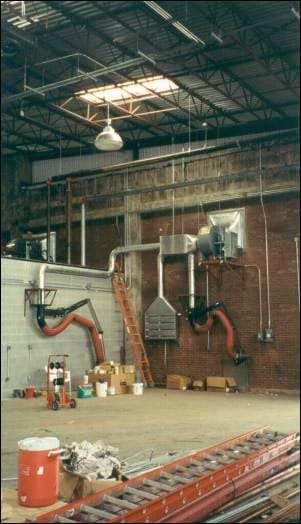Construction Laborer Dies from Injuries Received in a 33-foot Fall Through a Skylight Opening.

Investigation Report
April 4, 2000
99OK00901
SUMMARY
A 50-year-old laborer for a construction contractor died on March 30, 1999 from head injuries he received that day in a fall through a skylight opening. At the time of the incident, the victim was part of a two-man crew installing sealing tape on metal roof decking. The laborer stood, turned, and stepped through a skylight opening that had been uncovered in preparation for installing the skylight and roof decking. Co-workers called 911 and attempted to administer CPR. Emergency medical services arrived within five minutes of the incident, but the injuries sustained by the laborer in the fall were sufficiently severe to cause death within approximately two hours of the incident.
FACE investigators concluded that, to help prevent similar occurrences, employers should:
- develop fall protection systems and work practices that provide protection from falling through holes (including skylight openings) for all employees who work at heights of 6 feet or more above lower levels and provide training for all workers in the use of such practices and systems; and
- consider installing skylight fixtures that are sufficiently strong to support at least twice the weight of employees, equipment, and materials that may be imposed on the fixture at any one time. These skylight fixtures should be secured and marked to provide warning of the fall hazard.
INTRODUCTION
A 50 year-old laborer for a construction contractor died on March 30, 1999 from head injuries he received that day in a fall through a skylight opening. OKFACE investigators were notified of the incident, and a site visit was conducted on July 1, 1999. The FACE investigator reviewed the death certificate, the medical examiner’s report, the citation issued by OSHA, and media reports regarding the incident. The investigator also interviewed the owner of the company, surveyed the site of the incident, and interviewed two co-workers who were present at the time of the incident. The company employs between 80 and 150 people, depending on the number of projects in progress at any given time. Ten of the employees are managerial and administrative while the remainder are skilled tradesmen and laborers. The company has been in business for 33 years with no serious injury incidents prior to the date of the fatality. The deceased laborer had been employed for the company between 1992 and 1995, and had returned to work for the company three days before the incident. He had worked on the project where the incident occurred from the date of his return to the company.
The company has a formal safety program, including pre-written policies and practices purchased from a vendor. Each new employee, including the deceased laborer, undergoes a formal safety review upon employment and receives a copy of the company safety manual. All employees reporting to a new project receive an additional safety review regarding the hazards associated with the project. The company has a full-time employee whose responsibilities are dedicated to safety and quality control and who serves with other managers and employees on a safety council. The council meets weekly, and its membership rotates periodically. The safety manager conducts daily safety inspections of all project sites and all employees are required to attend weekly safety meetings. The fall hazards associated with roof edge work on this project had been identified and discussed with all employees working on the site; however, the exposure of workers to the skylight openings had not been sufficiently addressed as a potential fall hazard.
INVESTIGATION
At the time of the incident the work crew was installing sheet metal upper decking above a sheet metal sub-deck on a 0.75:12 slope. The deceased laborer had worked on a crew that had installed an 8-foot by 4-foot sheet of ½-inch plywood on each of the 16 skylight openings, all of which measured 9.5 feet long by 34 inches wide, in the roof of the building. The covers were anchored in place with sheet metal screws, but as the roofing project progressed, each cover had to be re-oriented transversely to the opening in a manner that left half of the opening exposed in order for work crews to install the roof decking and skylight components. A member of the work crew was designated to serve as safety monitor whenever operations were proceeding near the roof edge. The skylight work was proceeding well inside the roof edge and thus the safety monitor was not involved in the monitoring task. Weather conditions at the time of the incident included a clear sky, cool temperature, and light or no wind.
Immediately prior to the incident, the victim and a co-worker had re-oriented the cover onto the up-slope half of the first of the 16 openings and laid metal decking up to the down-slope edge of the opening. The skylight pan, the lower component of the plastic skylight, had been installed in the opening, and the two laborers were applying sealing tape to the up-slope edge of the newly installed roof decking at about 8:30 a.m. Another member of the work crew, the roof edge safety monitor, was located approximately 30 feet from the skylight opening at the time of the incident where he was obtaining measurements in preparation for work to be performed after the installation of the skylight. He was not acting as safety monitor since the work was being performed away from the roof edge. As the victim installed the sealing tape near the edge of the skylight opening, the co-worker was working approximately 10 feet away from the opening. The evidence suggests that the victim installed the sealing tape to the edge of the skylight opening, stood to re-position himself on the other side to continue the task, turned 90 degrees to his left, and stepped into the opening. The unsecured plastic skylight pan flexed under the weight of the worker and slipped out of the skylight frame allowing the victim to fall 33 feet to the floor of the building. The co-worker heard the noise generated by the collapse of the skylight pan and turned to see the victim slip through the opening. Both workers on the roof stated that the victim made no sound as he fell. Both men immediately descended to the floor of the building and checked the victim but could find no pulse. Emergency medical services responded within five minutes of the emergency call, which was made immediately following the incident, and transported the victim to a local hospital where he was pronounced dead two hours and seven minutes following the incident.
CAUSE OF DEATH
The medical examiner listed the cause of death as head injury.
RECOMMENDATIONS
Recommendation #1: Employers should develop fall protection systems and work practices that provide protection from falling through holes (including skylight openings) for all employees who work at heights of 6 feet or more above lower levels and provide training for all workers in the use of such practices and systems.
Discussion: A personal fall arrest system provides protection for employees working near skylight openings. The use of a personal fall arrest system that employs a full body harness, a self-retracting lanyard, and a proper anchor point accommodates worker movement over a wide area but immediately arrests a fall should the worker inadvertently step into an opening or over the roof edge. Providing a safety monitor who alerts workers of hazards when working near the edge of the roof is permitted under certain circumstances in OSHA regulations. However, in this instance, the work area where the skylights were being installed was not near the edge and therefore not under the scrutiny of the safety monitor. In these instances, a personal fall arrest system can be effective. Employers can also place standard guardrails around skylight openings or covers over them to protect their workers from falling through holes. Workers should be adequately trained to recognize fall hazards, be given the proper fall protection equipment for the job, and trained in the fall protection system. The use of a personal fall arrest system could have reduced or eliminated the risk of a fall in this circumstance.
Recommendation #2: Employers should consider installing skylight fixtures that are sufficiently strong to support at least twice the weight of employees, equipment, and materials that may be imposed on the fixture at any one time. These skylight fixtures should be secured and marked to provide warning of the fall hazard.
Discussion: The primary function of skylights is to provide ambient outdoor light into the building. The skylight fixture can be designed to serve this function and at the same time have sufficient strength to support at least twice the weight of employees, equipment, and materials that may be imposed on the cover at any one time. Architects, engineers, and employers should work together to ensure that skylight fixtures specified in the building plan meet this strength requirement. These skylight fixtures should be permanent and of sufficient strength to protect workers who access the roof from inadvertently falling through them. Workers should be alerted as to where the skylights are located. Skylight fixtures should be secured and marked to provide warning of the fall hazards, and workers should be advised against sitting or walking on them. Additionally, local building/construction code adoption and enforcement agencies should consider requiring skylight fixtures of this strength to be installed.
REFERENCES
29 CFR 1926.501 Duty to Have Fall Protection
29 CFR 1926.502 Fall Protection Systems Criteria and Practices
29 CFR 1926.503 Training Requirements
ILLUSTRATIONS
Figure 1. Building elevation

Figure 2. Skylight the decedent fell through

| The Oklahoma Fatality Assessment and Control Evaluation (OKFACE) is an occupational fatality surveillance project to determine the epidemiology of all fatal work-related injuries and identify and recommend prevention strategies. FACE is a research program of the National Institute for Occupational Safety and Health (NIOSH), Division of Safety Research.
These fatality investigations serve to prevent fatal work-related injuries in the future by studying the work environment, the worker, the task the worker was performing, the tools the worker was using, the energy exchange resulting in injury, and the role of management in controlling how these factors interact. |
To contact Oklahoma State FACE program personnel regarding State-based FACE reports, please use information listed on the Contact Sheet on the NIOSH FACE web site Please contact In-house FACE program personnel regarding In-house FACE reports and to gain assistance when State-FACE program personnel cannot be reached.
